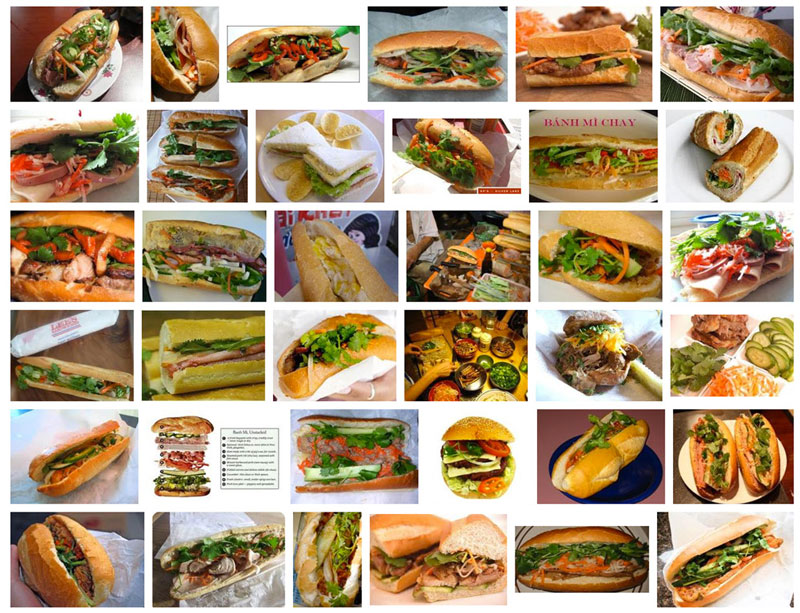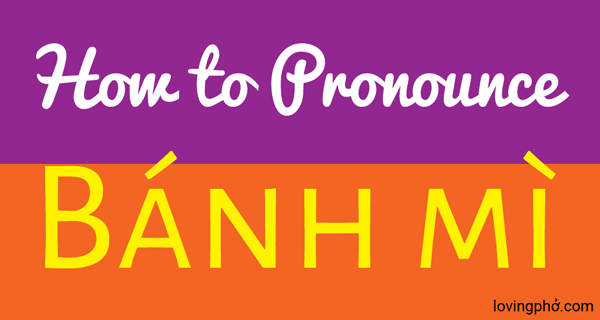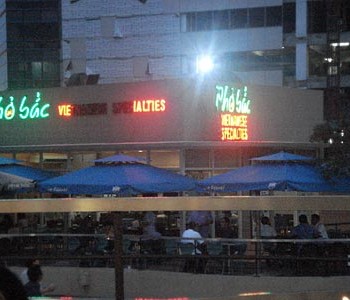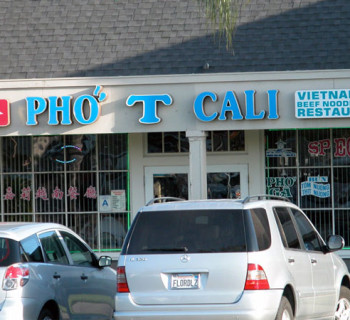Updated 01-11-18. Vietnamese bánh mì is not pho, of course, but I get inquiries about it often enough so here are the pronunciations for various bánh mì types. By the way, it is spelled bánh mì (banh mi) and never bahn mi as you may see around the Internet. "Bahn mi" with the h before the n (hn) is an incorrect spelling.
About the Word Bánh Mì
The words bánh mì is actually a two-syllable hyphenated word: bánh-mì. I digress here by saying highly recommend you check out the Wikipedia page on Vietnamese morphology for some interesting ways Viet people use our language, including hyphenated words.
Back to banh mi. So before arrival of the French baguette, Viet people had a lot of different types of baked treats call "bánh" this and "bánh" that (more on this a few paragraphs down). After introduction of the French baguette, Vietnamese added bánh mì which is a bánh baked with wheat flour using the French baking technique.
The Vietnamese word bánh mì itself has two main meanings. One, banh mi in general means a loaf/slice/piece of bread, most often related to the French baguette, but banh mi can also be used to describe sliced bread and other breads. It basically means bread of any kind. Two, banh mi refers to the bread stuffed with a variety of meats and Viet pickles. It is what most North Americans know as the submarine sandwich. In a Viet sandwich shop, you can buy not only the bread-stuffed-with-meat sub sandwich kind of banh mi, but also the whole baguette banh mi if you're lucky enough that it's also a bakery with onsite ovens.
"Bánh" itself really has several meanings, but in this context it means any flour-, rice- or wheat-based food that is baked, cooked, or steamed. Examples are bánh ngọt (means sweet cake), bánh bao (means ball-shaped steamed dumpling), and bánh chưng (means rice cake). "Mì" also has several meanings (one of which is egg noodle) but in this context it means bột mì or wheat flour.
For a more detailed story on Vietnamese Banh Mi, head on over to read Andrea Nguyen's post on banh mi, "Master Banh Mi Sandwich Recipe."
Pronounce: Various types of Vietnamese bánh mì.
- Bánh mì gà (banh mi with grilled chicken.) Southern accent then Northern accent. Bánh mì gà
- Bánh mì trứng (banh mi with egg-omelette style.) Southern accent then Northern accent. Bánh mì trứng
- Bánh mì bì (banh mi with shredded pork.) Southern accent then Northern accent. Bánh mì bì
- Bánh mì thịt nướng (banh mi with grilled pork.) Southern accent then Northern accent. Bánh mì thịt nướng
- Bánh mì xiú mại (banh mi with pork meatballs.) Southern accent then Northern accent. Bánh mì xiú mại
- Bánh mì thịt nguội (banh mi with cold cuts-cured pork & pork roll.) Southern accent then Northern accent. Bánh mì thịt nguội.
- Tôi muốn ổ bánh mì chay (I would like a vegan sandwich, please.) Southern accent then Northern accent. Tôi muốn ổ bánh mì chay.
- Bánh mì đặc biệt (Special banh mi). Southern accent then Northern accent. Bánh mì đặc biệt.
Thanks to Christian Belanger and Jim Fung for the request for the audio files.
If you have another type of banh mi you'd like to hear, please drop a request in the comment below. Okay this is a pho blog, so please take a poll below.






Hi Karen T: There are of course many ways to call out an order. I opted for the more common way of street ordering, which normally does not use an equivalent of “please” but is not really considered rude either. It’s just the way it is, matter of fact and quick. Also you used “tofu” or “đậu hủ” in Vietnamese, but then also used “chay” which means “vegan.” Vegan would be the more commonly acceptable way so that’s what I used in the pronunciation.
So it would be “Tôi muốn ổ bánh mì chay” which means “I would like a vegan sandwich.” The pronunciation of this is #7 above. Thanks for your request.
The pure Hanoi accent as you mentioned above now is almost disappeared. It’s not what we used to hear in the south after 1954. Hanoi accent today is mixed with Nghe An, Thanh Hoa let alone is higher pitch.
Hi Thanh Nguyen: thank you for your comments. You make a good point. There are differences between the various northern accents, and southern accents, for that matter. My goal here is to help those not familiar with the Viet language to start understanding that there are differences. In fact what I chose to do was a generic “northern accent” and not necessarily Hanoi accent. In the discussion above with Accent Police, we did address some of your points. I welcome any additional ideas you may have.
Hi Cuong! Have you noticed that Hanoi accent today is 1/2 higher than those who emigrated to south Vietnam. I have met a lot of young people who claim themselves Hanoians and speak Hanoi accent 🙂 ( these people when you ask them where their parents are from I guarantee 80% they’re from central Vietnam (Nghe An, Thanh Hoa, Ha Tinh , Quang Tri, Hue ..and moved to Hanoi after 1954) I love old Hanoi accent even though I’m southerner. A precious cultural heritage of Hanoi accent is lost.
Hi Thanh Nguyen: I have yet to recently meet anyone from Hanoi with what one considers pure “Hanoi” accent so I can’t compare to those who came to the South in 1954. The time difference between any given language itself would result in different accent, or different way of saying things, I suppose. For example, English as spoken today in the USA would be different from that spoken during World War 2, just because of generational and other influences. For Vietnamese language, I think there are numerous influences going on now that the language is being challenged all the time. And I think it will continue to change in the future.
Here in Dallas, Texas, I noticed that “Pho is For Lovers” on Greenville Avenue has just recently opened.
While doing a Google search to learn more about pho, I discovered your site.
Thank you for a wonderful resource! It is a delight to read.
Hi Cuong, thanks for your efforts on creating such a great resource. We are travelling to Southern Vietnam for the first time soon, and are looking forward to tasting all the amazing food. However, my very strange husband *hates* cucumber – whereas I love it. We’d like to know hot to say “NO Cucumber, thanks”, “Cucumber fine on mine, thanks!” Hope you can help or there’s gonna be tears!!